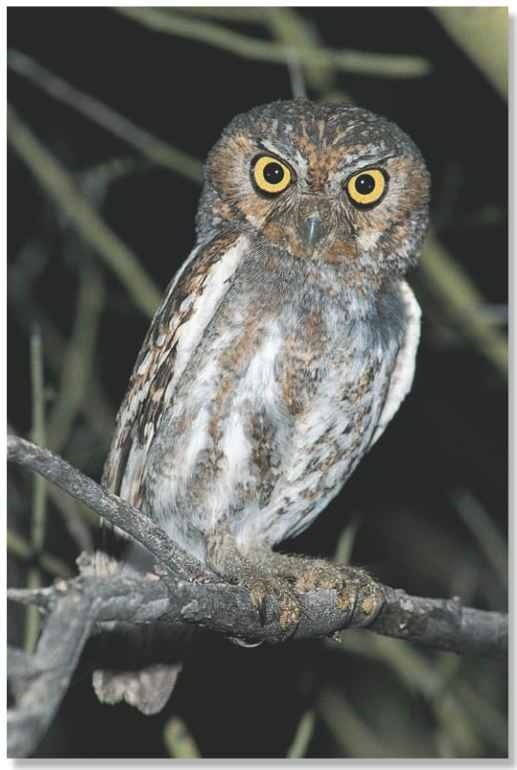ORDER
Strigiform.es
FAMILY
Strigidae
GENUS & SPECIES
KEY FEATURES
• The smallest owl in
the world; at 5-6” long, it is roughly the size of a sparrow
• Relies entirely on
abandoned woodpecker holes in cacti and trees for nesting sites
• Acute hearing allows it to locate prey in the darkness of night
• The most nocturnal owl found in all of North America
WHERE IN THE WORLD?
Found in North America from southeastern California west to northeastern New Mexico, and from southern Texas to central and southern Mexico, including the tip of Baja California
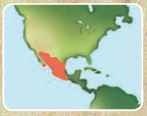
Lifecycle
Despite its small size, the elf owl has an extraordinarily loud voice; its rapid series of high-pitched notes are an advertisement for protecting its territory and attracting a mate.
HABITAT
The elf owl inhabits the wooded canyons and deserts throughout Mexico and the southwestern United States. This owl is very common in the dry, upland Sonoran deserts up to about 7,000′, which are dominated by the giant saguaro cactus (Carnegiea gigantea).The elf owl can also be found on low plains and streamside thickets with cottonwood, sycamore and almost any other types of trees, but typically avoids areas with solid stands of pines. The elf owl’s habitat is greatly dependent upon abandoned woodpecker holes for nesting sites, and on an abundance of insects for its food supply.

Mostly found in the desert, elf owls also inhabit forests.
BREEDING
Elf owls breed from April to June, and the birds depend on deserted woodpecker holes located in both cacti and trees for nesting sites.The male arrives first at a prospective site and begins singing from the cavity to entice a female. The female responds with her own song and enters the nest site, where the pair forms a bond and mates. No nesting material is used; the female lays 1-5 eggs (usually 2 to 3) inside the cavity and incubates alone for 21-24 days.The male feeds the female during the incubation period and also feeds the young once they hatch.
Upon hatching, the young owls are covered in white downy feathers and are completely dependent upon their parents for food and protection. The chicks will fledge within 2733 days, and they begin to capture insects on their own as soon as they are able to fly. The amount of time that the young owls remain with their parents after fledging is still unknown.
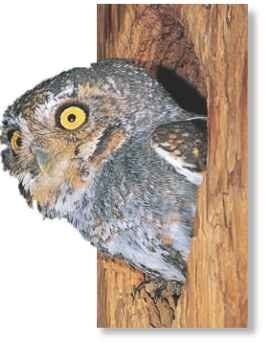
FOOD & FEEDING
The nocturnal elf owl comes out at dusk and hunts for prey throughout the night. Unlike its larger relatives, it feeds almost exclusively on insects, such as beetles, moths, crickets and grasshoppers, as well as
arachnids, such as spiders and even scorpions — after crushing and removing their sting. Occasionally, the elf owl takes larger prey such as lizards and small snakes. Most prey is caught in the owl’s feet while in flight; however, it also hunts from a perch and even pursues prey while running on the ground. It uses its sharp, hooked bill to tear its prey into pieces that can be swallowed.
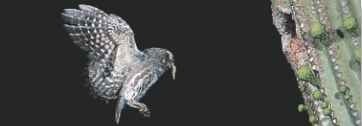
A Bring home the bacon A male elf owl returns to his nest with dinner for both his mate and his young chicks.
IN THE STILL OF THE NIGHT
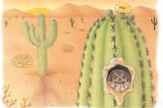
1 Emerging…
With just its head visible through a hole in a large saguaro cactus, the elf owl emerges at dusk to forage for food.
The elf owl is the tiniest owl in the world; jit is so small and delicate that it can be knocked out of the air in mid-flight by a robin or other songbird.
The elf owl has about 15 different vocalizations; its yips are very similar to the sounds made by a puppy.
When captured, this tiny owl fakes death.
Woodpecker hole Small enough to enter a woodpecker hole, the elf owl lays its eggs and raises its chicks in a deserted cavity. This hole provides a warm nesting site that is well protected from predators.
CONSERVATION
The elf owl is not currently endangered and is very common in most of its range. However, this bird is directly dependent upon nesting holes made by birds, such as woodpeckers, as well as an abundant supply of insects for food. In California and Arizona, the elf owl population is declining due to habitat destruction; however, in New Mexico and Texas the owl’s range and number are growing. The elf owl is listed ; on Appendix II of CITES (Convention for International Trade of Endangered Species). Like all owls, it is protected by law in the U.S., and a permit is required to keep one in captivity.
BEHAVIOR
The elf owl is the most nocturnal of all North American owls and remains inactive during the day unless disturbed. It spends the daylight hours roosting on a tree branch or in a bush to escape the intense desert heat and to avoid predators, such as large birds of prey. Since its diet consists mainly of insects, spiders and scorpions, the elf owl is extremely migratory throughout its range and must travel south during the winter months — the cold weather causes its prey to either hibernate or die. In October, the elf owl gathers in large flocks to make the migration south; the birds will return to their breeding grounds by mid-March.
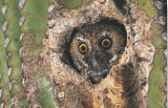
1 AT Inside or out
The elf owl roosts by day (above) and hunts from a perch at night
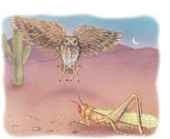
2 Swooping…
With outstretched talons and wings held high to slow it down, the owl swoops and strikes at a grasshopper on the ground.
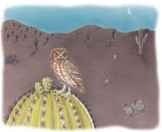
3 Watching…
After eating its first course, the elf owl scans the ground below, watching for any type of tiny, flying insect prey.
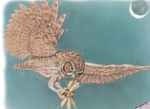
4 Snatching
Spotting a potential meal, the elf owl flies down from its perch and snatches a large flying beetle in midair with its sharp talons.
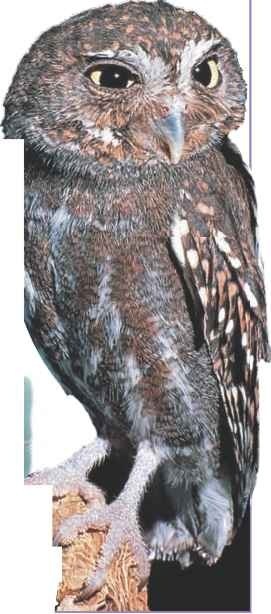
![]()
Profile
Elf Owl
With its small size, lack of ear tufts, yellow eyes and short tail, the elf owl is easily distinguished from all other small owls in its range.
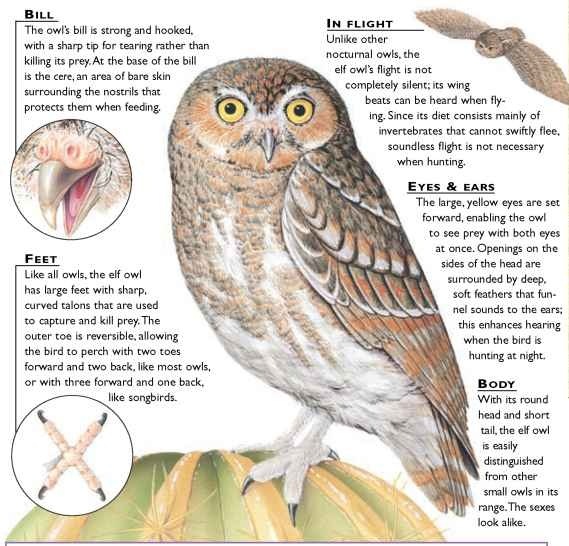
CREATURE COMPARISONS
At 13-16″ long and with a wingspan of 36-42″, the long-eared owl (As/o otus) is much larger than the elf owl. As its name suggests, the long-eared owl has long ear tufts, along with chestnut facial disks and a mottled brown and tawny plumage; the elf owl lacks ear tufts and has similar plumage streaked with white.The long-eared owl is found in the deciduous and evergreen forests from Alaska to Mexico, but the elf owl is mostly found in the wooded canyons and deserts of the southwestern U.S. and Mexico.
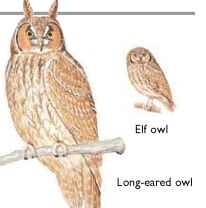
| STATISTICS | |
| Weight | 1.25-1.75- oz. |
| Length | 5-6” |
| Wingspan | About 15” |
| Sexual [ Maturity | Unknown |
| Breeding Season | April-June |
| Number of Eggs | 1-5; usually 2-3 |
| Incubation Period | 21-24 days |
| Fledging E Period | 27-33 days |
| Breeding t Interval | -1 year |
| Typical ! Diet | Mainly insects, spiders and scorpions; sometimes lizards and small snakes |
| Lifespan | 7-10 years |
RELATED SPECIES
The elf owl is the only ‘ species in the genus tMicrathene. The order Strigiformes contains 10 species of barn owls in the family Tytonidae and about 175 species of true owls in the elf owl’s i I family, Strigidae. The elf fowl’s closest relatives include the northern [ Pygmy owl, Glaucidium gnoma, the ferruginous I Pygmy owl, G. brasilianum and the western screech owl, Otus kennicotti.
